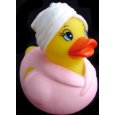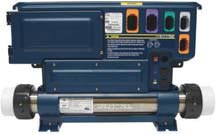Hot Tub Electrical Problems
 Hot tubs are stress relievers up until the day they stop working. Fortunately, in modern spas there are error codes that show up on the topside control display to help troubleshoot any errors.
Hot tubs are stress relievers up until the day they stop working. Fortunately, in modern spas there are error codes that show up on the topside control display to help troubleshoot any errors.
Caveat: Never attempt to do electrical repairs on any appliance or device that you are not qualified to do as the mix of water and electricity can be extremely dangerous.
Hot Tub Electrical Problems
 When the duck stops swimming, its time to find out why the spa doesn't work again. Spa technicians often use a technique of divide and conquer. Finding out if a problem is upstream or downstream from a particular spa component can help localize the problem component.
When the duck stops swimming, its time to find out why the spa doesn't work again. Spa technicians often use a technique of divide and conquer. Finding out if a problem is upstream or downstream from a particular spa component can help localize the problem component.
 Hot Tub Problems
Hot Tub Problems
There are many symptoms that can cause a problem with spas. From a general wiring and circuit breaker issue that can render the entire spa useless, to a particular component within the spa that may be causing a short circuit or other electrical issue. Hot tub components that can cause issues include:
- GFCI
- Circuit Breaker
- Spa Pack
- Spa Topside Control
- Hot Tub Circuit Board and Relays
- Spa Heater
- Ozonator
- Air Blower
- Pumps
- Circulation Pumps
![]() Hot Tub Problem Solving
Hot Tub Problem Solving
Circuit Breaker Tripping?
This is a problem that requires troubleshooting skills to isolate the problem component. Culprits could be any one of the many components attached to the spa such as an air blower that has water buildup inside of it causing a short circuit etc..
When a spa does not work at all, technicians check the main spa leads for power to determine whether the problem is within the spa or outside of the spa in the main wiring or panel.
Many times if the problem is within the spa, technicians will unplug the individual components and plug them in one by one until the fault occurs. If the spa pack works with no components attached to it, then the problem may be with one of the pumps, blowers, ozonators or other devices plugged into the spa pack or circuit board.
Once a component has been found to have a problem, the part can easily be replaced by ordering a similar replacement part online, many times with free delivery. The part is then swapped out and the spa is up and running again.
Typical components that are exchanged in spas include the heater, pumps, blower and even circuit board or entire spa pack.
Most often, circuit boards are not repaired, but just replaced, although there are repair kits available for pumps and sometimes only the wet end of a pump is needed, so it is cheaper to buy just that part rather than the entire pump. If the pump is older than about 5 years, then it makes sense to just change out the entire pump if that was the component that caused the problem as pump seals can begin to wear over time, especially when subject to imbalanced water over extended periods of time.